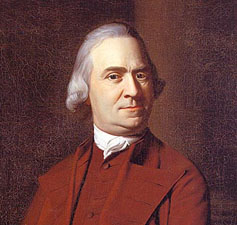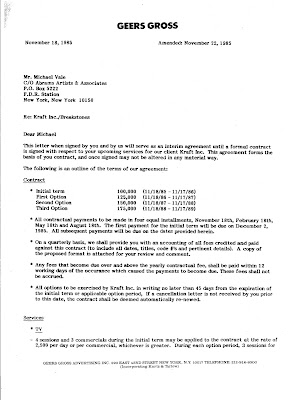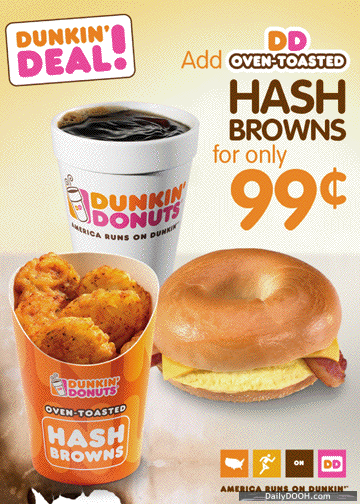There are certain times when I really miss this guy:
 |
| Pictured: Not Eliot Spitzer |
That's my former law school dean and contracts professor,
Howard Hunter. He wrote a treatise on
Contract Law. If I'd read it, I might have passed his class. Also, I might have a better handle on how to interpret the contract sent to me by Nancy Vale.
The letter agreement, from November 1985, is the contract for Michael Vale to continue portraying Sam Breakstone. It is signed by Michael and Geers Gross Advertising, as agent for Kraft Dairy Group. It came at a time when the Sam Breakstone campaign was winding down and the Dunkin' Donuts' "Time To Make The Donuts" campaign had already taken off.
It's an amazing look into how advertisers and entertainers work together, and just how much Sam Breakstone was worth. I have retouched a few details to protect Nancy Vale's privacy. Before you go knocking on doors, she hasn't lived at the address in the contract for some decades.
Michael apparently received $100,000.00. This entitled Geers Gross to demand a minimum amount of work, but he got that $100,000.00 even if they had him do less ... including nothing.
Most of the work he was required to do is on this page. He had to do four days of work shooting three commercials, and would be paid $2,500.00 per day for anything above that. There's some language about reuse of commercials which I ... do not understand.
He was obliged to do radio commercials. If they exceeded his base, he received $1,000.00 per commercial. Reuse of commercials was extra and didn't count towards his base.
He had to sit for two days of still photography. Additional days were paid at $2,500.00 each above his minimum. The pictures could be used for for magazines and POP. What is POP? Point of Purchase. It means a big cardboard cut-out of him in the supermarket. Once his $100,000.00 minimum was reached, Geers Gross had to pay up to $4,000.00 every three months to put his photograph in a magazine ad.
Once they met his minimum, personal appearances cost $3,000.00 each. If Kraft wanted Michael Vale to show up somewhere, they had to hand him three thousand dollars.
Publicity appearances cost $2,500.00. What's the difference between a personal appearance and a publicity appearance? Really. I'm asking you. I have no idea.
Michael was paid $750.00 a day to travel. It had to be by first class, include hotel and meals for two plus $200.00 a day walking around money.
The balance of page three and the start of the next involves apportioning the monies to comply with Screen Actors Guild and American Federation of Television and Radio Actors requirements. Michael Vale was a member of more than one union, and they were required to follow union rules. That included sending money directly to the unions' pension funds.
Probably the coolest thing on this page is that the letter references standard clauses in the final contract like force majeure and morals. If a war broke out, preventing Kraft from shooting commercials, they wouldn't be liable under the contract. If Mr. Vale tweeted insensitive things about
the Japanese tsunami victims, they could fire him.
Being under contract as a commercial actor is fairly rare. Usually, actors are hired for one commercial at a time. The fact that Mr. Vale was under contract at all shows just how seriously invested Kraft was in the character he brought to life. This would be the top tier of payment for a commercial actor (except for celebrity endorsement deals). So, is it more or less money than you thought.
If Geer Gross wanted to shoot four days of commercials in Los Angeles, the costs just for one actor were:
$1,500.00 - Two Travel Days
$2,000.00 - Two First Class Tickets
$1,000.00 - Four Nights Hotel Accommodations
$800.00 - Four Nights Meals
$800.00 - Per Diem
$10,000.00 - Four Day Commercial Shoot
$3,000.00 - Meet and Greet with Kraft Executives
TOTAL: $19,100.00 for six days.
According to this
inflation calculator, Michael Vale's $100,000.00 minimum would be $208,147.20 today and the above total would be almost exactly forty thousand dollars. In fairness, Michael Vale split that money with his agents, managers, unions, the United States of America, and the State of New York. How much of each dollar earned he actually kept is unknown.
Was Michael Vale fairly compensated? Was he overcompensated? And is it even possible to calculate how much money Kraft made due to his efforts? Can you believe that number is still growing? Kraft is still making money today because of the brand image he helped build decades ago.
This is the first time this contract has seen the light of day in twenty-six years. Copy, link, share.














